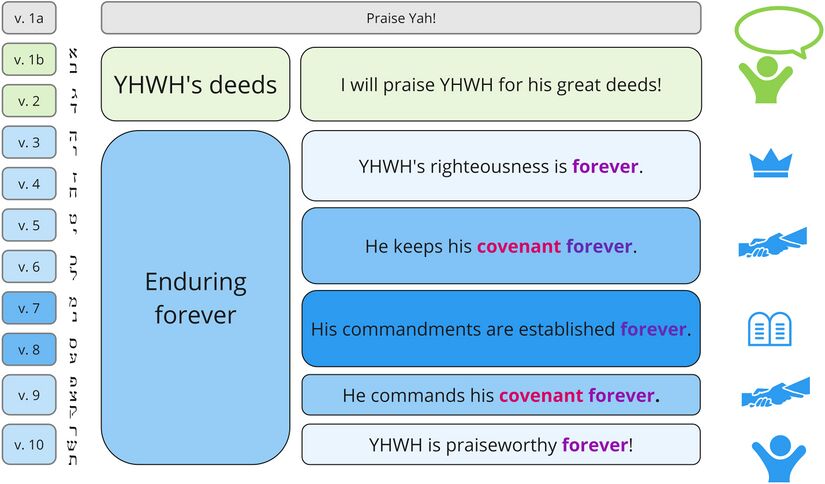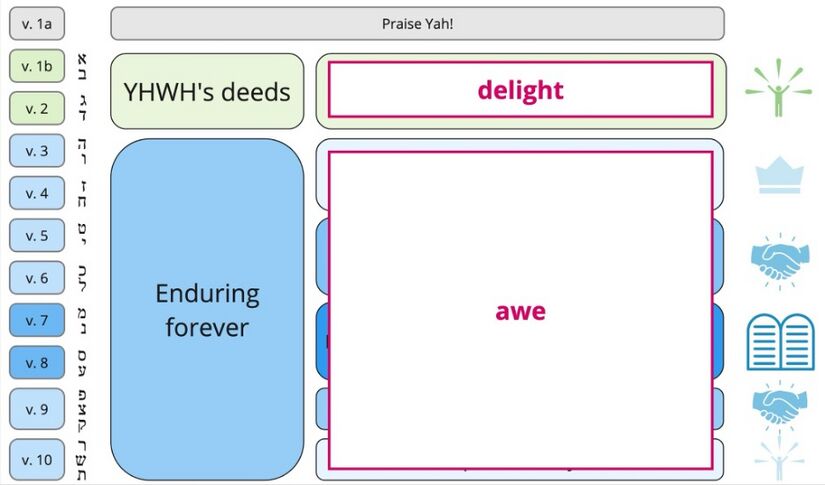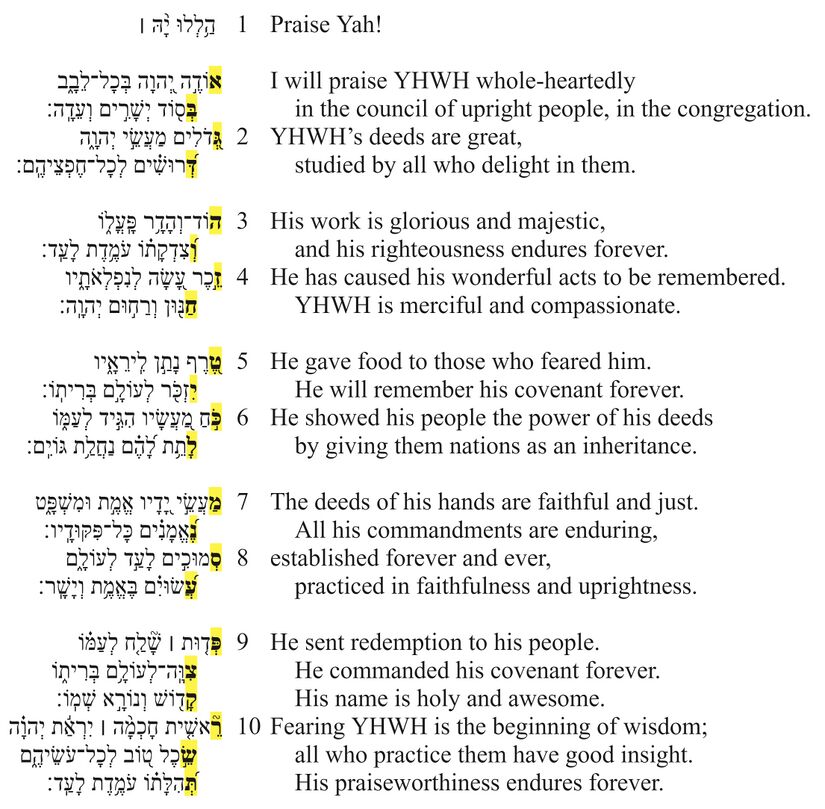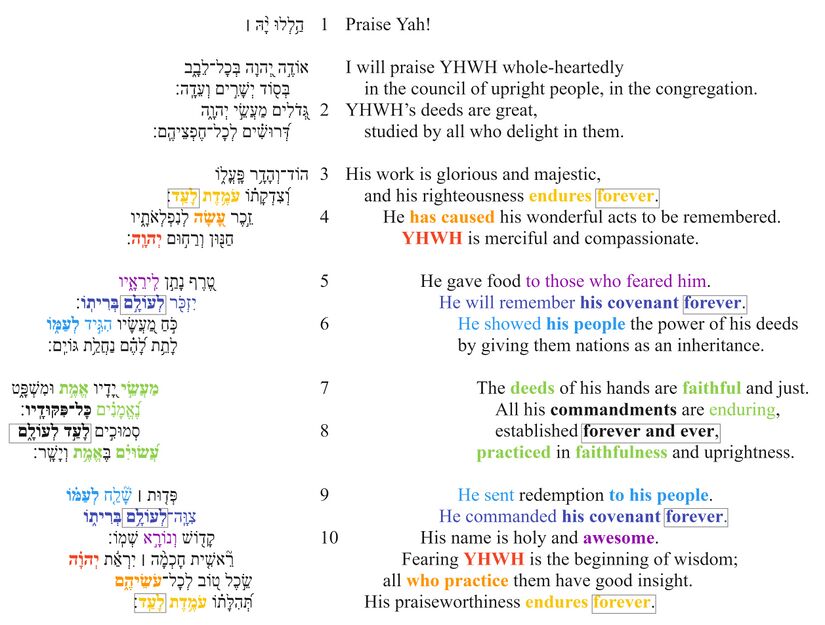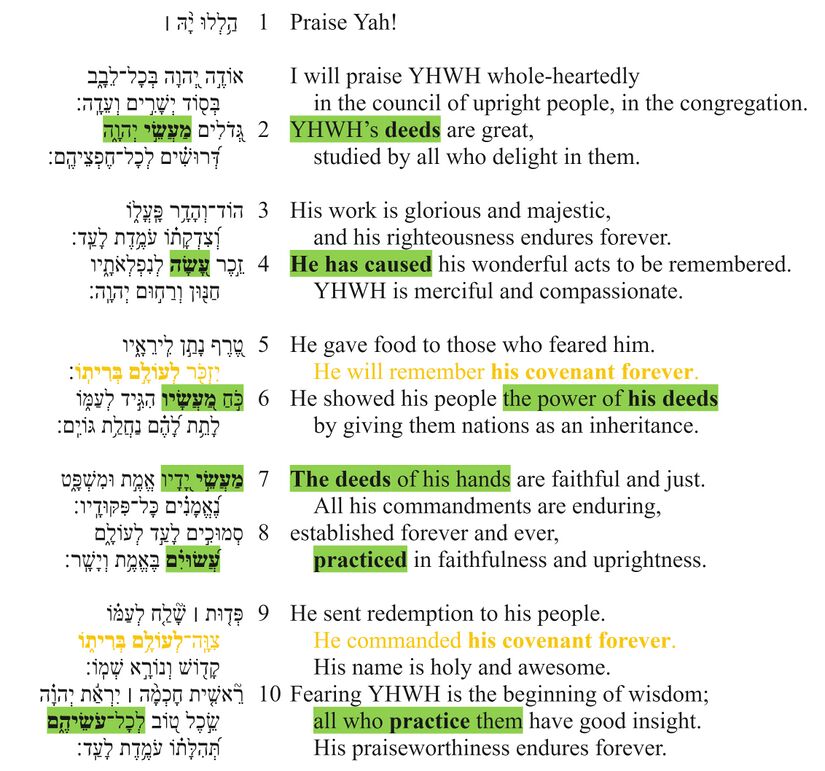Psalm 111/Translation/Tips
The following gives a basic Overview of the Psalm, answering the following questions:
- Title-what title best describes this unique psalm?
- "YHWH's deeds"
- Purpose–why was this psalm written?
This psalm was written to praise YHWH for his deeds of covenant faithfulness.
- Content–In summary, what is said in this psalm?
- YHWH's deeds are great and his commandments are enduring.
- Message–what is the general theme of this psalm? What seems to be the main point the psalmist wanted his audience to realize by hearing this psalm?
- YHWH, our God, has done great deeds for us, and, we his people, do his commandments.
- See Prominence Feature 2: Great Deeds for more detail.
Every psalm has a coherent story behind it. However, many
psalms are not written in typical "story" format, with a clear
beginning, middle, and end. Here, we attempt to understand the story and
background that prompted the psalmist to write.
- Story Behind-How do the various parts of the psalm fit together into a single, coherent story? What is the main message/theme conveyed by this "story behind"?
 YHWH promises to perform great deeds for his
people.
YHWH promises to perform great deeds for his
people.  The
people wait for YHWH to perform great deeds.
The
people wait for YHWH to perform great deeds.  As
they wait, the psalmist celebrates YHWH's great deeds of the past. YHWH's past
deeds always happened according to a pattern:
As
they wait, the psalmist celebrates YHWH's great deeds of the past. YHWH's past
deeds always happened according to a pattern:
- YHWH promised to perform great deeds for his people, then
- YHWH performed great deeds for his people, and then
- The people celebrated YHWH's great deeds and kept his commands.
- As he composes his psalm, the psalmist anticipates that the people will praise YHWH and keep his commands as they wait. Then YHWH will perform great deeds for his people, and the people will celebrate YHWH's great deeds.
- Background Situation-what are the series of events leading up to the time in which the psalm was written?
Knowing the layout of the psalm by sections helps us to understand the progression of thought as the poem progresses.
How to read the visual below: The picture below shows the main “chunks” or pieces of the poem. Verse numbers appear on the left. The second column has a title for each section. The large third column contains a brief summary of the section’s content. As you read through the content column, you will see important words and ideas highlighted in similar colors. The icons on the right may be used as memory aids.
Progression–what is the flow of thought as the poem progresses?
- Broadly speaking, this psalm is about YHWH's great deeds and character.
- The first major section, verses 1-2, is an introduction:
- the psalmist declares his intention to praise (verse 1)
- the psalmist introduces the theme of the poem (verse 2).
- The second major section, verses 3-10, contains the praise itself, focusing on:
- YHWH's character (verses 3-4)
- YHWH acts of covenant faithfulness (verses 5-6)
- YHWH's commandments (verses 7-8)
- how YHWH's people should respond to his great deeds (verses 9-10).
Part of poetry is communicating emotion. Each section, and even each verse, can contain a number of different emotions. Here are the main emotional themes of each section:
In poetry, it is important to keep track of who is speaking, who is the audience, and what it is that the speaker is trying to do with his words.
How to read the visual below: In the chart below, the left-hand column identifies the speaker, who is the psalmist. The right-hand column identifies the audience, who is the Congregation in this psalm. The middle column tells what the speaker is trying to do with his words (his speech acts) in each section.
In this section, we ask, "what kinds of artistic beauty did the psalmist incorporate into the poem to reinforce its message?" (See Poetic Features video and layer for more details.)
YHWH's Deeds from A to Z
Psalm 111 is an acrostic poem. In an acrostic poem, each line begins with a successive letter of the Hebrew alphabet (so is Psalm 112).
The alphabet is a symbol of completeness.<ref>See Gottwald 1954, 23-32; IVP Dictionary, “Acrostic”; Soll, Anchor Bible Dictionary; Watson, Classical Hebrew Poetry 2001.</ref> In an acrostic poem, the poet takes a topic and explains it carefully and completely, from every possible angle. The purpose is that the reader would gain a thorough, detailed understanding of the topic, so that he or she understands it “from A to Z.” In Psalm 111, the topic is "YHWH's deeds" (מַעֲשֵׂי יְהוָה).
Prominence–what words, phrases, or ideas are most important in this psalm?: It is also important to consider how the author chose to draw attention to certain parts of the psalm. Here are the parts of the psalm that we believe are most prominent, and thus should be most prominent in a performance of the psalm.
Prominence Feature 1: Eternal Commands
Verses 7-8 are the most prominent verses in the psalm. Within those verses, the words 'deeds/practice,' 'faithfulness,' and 'commands' are the most prominent words. We know this because this psalm contains a special structure called a chiasm that spans from verse 3b to verse 10c. In a chiasm, the first line and the last line share repeated or similar features, and then the second line and the second-to-last line share repeated or similar features, and so on. The lines that match in the middle are the focus of the chiasm (verses 7-8).
The middle of the chiasm contains the repeated Hebrew roots for deeds/practice (עשׂה) and faithful(ness) (אמת) in verses 7 and 8. So, Psalm 111 is a celebration of YHWH's faithful deeds. Although the psalm celebrates many of YHWH's deeds, the chiastic structure highlights one deed in particular: YHWH's commands (verse 7b).
The psalmist has placed the word "commands" at the center of the chiasm, he describes the commands with the phrase "forever and ever", and he makes the commands the subject of three consecutive verses (verses 7b–8b). Furthermore, the commands are surrounded by the threefold repetition of the root faithful(ness)/enduring (אמת/אמן). YHWH's commands are both given (by him) in faithfulness and they are to be done (by his people) in faithfulness.
Prominence Feature 2: Great Deeds
The root that means to do or deeds (עשׂה) occurs six times in Psalm 111 (verses 2a, 4a, 6a, 7a, 8b, 10b), one time in each section and twice in the fourth section. The first four occurrences refer to YHWH's deeds (verses 2a, 4a, 6a, 7a), and the last two occurrences refer to the deeds of YHWH's people (verses 8b, 10b).
The repetition functions to highlight the theme of the psalm, which is YHWH's deeds. But the repetition also functions to make a point about how people ought to respond to YHWH's deeds. By using the word twice with people as the agent, the psalmist shows that the proper response to YHWH's deeds of faithfulness is that his people perform deeds of faithful obedience in return. In short, the covenant relationship between YHWH and his people is to be characterized by doing (עשׂה).

